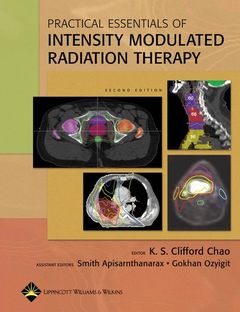Description
Practical essentials of intensity modula ted radiation therapy, (2nd Ed.)
Author: CHAO Clifford K.S.
Language: English
Subjects for Practical essentials of intensity modula ted radiation...:
Approximative price 179.95 €
Subject to availability at the publisher.
Add to cart
Publication date: 10-2004
324 p. · Hardback
324 p. · Hardback
Description
/li>Contents
/li>Comment
/li>
The primary objective of this book is to teach trainees, fellows and clinicians in radiation oncology how to incorporate IMRT into their practice. IMRT has proven to be an extremely effective treatment modality for head and neck cancers. It is now being used effectively in other sites, including, prostate, breast, lung, GYN, the cervix, CNS and lymph nodes. The book will provide in a consistent format an overview of the natural course, lymph node spread, diagnostic criteria, and therapeutic options for each cancer sub site. NEW TO THIS EDITION: 8 new chapters added (Instrumentation/QA/Optimization/Planning, PET Scanning & IMRT, Prostate Cancer, Breast Cancer, GYN Cancer, Cervical Cancer, Lung Cancer, Lymph Node Cancer). 4 other chapters combined into 2. Existing chapters updated with new clinical data.
IMRT Physics and Quality Assurance. Optimization for Planning of IMRT. CT and MR Imaging of Brain and H&N Cancers. CT and MR Imaging of Abdomen and Pelvis. PET Imaging for IMRT. Posterior Fossa and Skull Base Tumors. Nodal Target Volume for Head and Neck Cancer. Nasal Cavity and Paranasal Sinuses. Nasopharynx. Oral Cavity. Oropharynx. Hypopharynx and Larynx. Metastatic Carcinoma in Neck Node with Unknown Primary. Breast Cancer. Thoracic Cancer. Pelvic and Para-aortic Nodal Target Delineation. Prostate Cancer. Gynecological Cancer.
'
International Journal of Radiation Oncology Biology Physics, Volume 62, Issue 3 -- ''The use of intensity modulated radiation therapy (IMRT) in academic centers as well as in community-based radiation oncology practices continues to increase. This book provides an excellent guide to cross-sectional anatomy of the primary site and nodal drainage basins for most head-and-neck primary tumor subsites. It integrates CT, PET, and MR imaging using full color to provide numerous examples of target volume and normal tissue delineation. This book is more than an atlas of radiographic anatomy, though. Most chapters discuss anatomy, natural history and routes of tumor spread, imaging modalities and staging, determination and delineation of target volumes and normal tissues, dose prescription, an
© 2024 LAVOISIER S.A.S.




